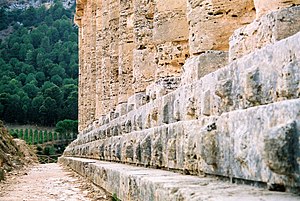στυλοβάτης: Difference between revisions
καλῶς γέ μου τὸν υἱὸν ὦ Στιλβωνίδη εὑρὼν ἀπιόντ' ἀπὸ γυμνασίου λελουμένον οὐκ ἔκυσας, οὐ προσεῖπας, οὐ προσηγάγου, οὐκ ὠρχιπέδισας, ὢν ἐμοὶ πατρικὸς φίλος → Ah! Is this well done, Stilbonides? You met my son coming from the bath after the gymnasium and you neither spoke to him, nor kissed him, nor took him with you, nor ever once felt his balls. Would anyone call you an old friend of mine?
mNo edit summary |
m (Text replacement - "<span class="sense"><p>" to "<span class="sense">") |
||
| Line 8: | Line 8: | ||
|Transliteration C=stylovatis | |Transliteration C=stylovatis | ||
|Beta Code=stuloba/ths | |Beta Code=stuloba/ths | ||
|Definition=[<b class="b3">ᾰ], ου</b>, Dor. [[στυλοβάτας]], ὁ, <span class="sense" | |Definition=[<b class="b3">ᾰ], ου</b>, Dor. [[στυλοβάτας]], ὁ, <span class="sense"> <span class="bld">A</span> [[base of a column]], [[stylobate]], <span class="bibl">Pl.Com.42</span>, <span class="title">Delph.</span>3(5).88 <span class="title">C</span>2 (iv B.C.), <span class="title">IG</span>22.1668.40, 42(1).102.8, al. (Epid., iv B.C.), <span class="title">Inscr.Délos</span> 365.30 (iii B.C.), <span class="bibl">Hero <span class="title">Aut.</span>16.1</span>, Vitr. 3.4.2, 4.8.2.</span> | ||
}} | }} | ||
{{pape | {{pape | ||
Revision as of 23:20, 11 December 2020
English (LSJ)
[ᾰ], ου, Dor. στυλοβάτας, ὁ, A base of a column, stylobate, Pl.Com.42, Delph.3(5).88 C2 (iv B.C.), IG22.1668.40, 42(1).102.8, al. (Epid., iv B.C.), Inscr.Délos 365.30 (iii B.C.), Hero Aut.16.1, Vitr. 3.4.2, 4.8.2.
German (Pape)
[Seite 958] ὁ, Säulenfuß, Plat. com. bei Poll. 7, 121.
Greek (Liddell-Scott)
στῡλοβάτης: [ᾰ], -ου, ὁ, ἡ βάσις στύλου, Πλάτ. Κωμικ. ἐν «Ἑορτ.» 12, Ἥρων ἐν «Αὐτομ.» 259Β, Βιτρούβ. 3. 3., 4. 7.
Greek Monolingual
ο, ΝΑ, και δωρ. τ. στυλοβάτας Α
βάση στύλου, υπόβαθρο, κν. στυλοπάτι
νεοελλ.
1. μτφ. βασικός υποστηρικτής, θεμελιωτής («στυλοβάτης της κυβέρνησης»)
2. αρχαιολ. η άνω επιφάνεια του κρηπιδώματος ναού η οποία αποτελείται από μεγάλες τετράγωνες πλάκες άριστα κατεργασμένες και προσαρμοσμένες η μία προς την άλλη και πάνω στην οποία στηρίζονται οι κίονες.
[ΕΤΥΜΟΛ. < στῦλος + -βάτης (< βαίνω), πρβλ. ορει-βάτης.
Greek Monolingual
ο, ΝΑ, και δωρ. τ. στυλοβάτας Α
βάση στύλου, υπόβαθρο, κν. στυλοπάτι
νεοελλ.
1. μτφ. βασικός υποστηρικτής, θεμελιωτής («στυλοβάτης της κυβέρνησης»)
2. αρχαιολ. η άνω επιφάνεια του κρηπιδώματος ναού η οποία αποτελείται από μεγάλες τετράγωνες πλάκες άριστα κατεργασμένες και προσαρμοσμένες η μία προς την άλλη και πάνω στην οποία στηρίζονται οι κίονες.
[ΕΤΥΜΟΛ. < στῦλος + -βάτης (< βαίνω), πρβλ. ορει-βάτης.
Wikipedia EN
In classical Greek architecture, a stylobate (Greek: στυλοβάτης) is the top step of the crepidoma, the stepped platform upon which colonnades of temple columns are placed (it is the floor of the temple). The platform was built on a leveling course that flattened out the ground immediately beneath the temple.
Some methodologies use the word stylobate to describe only the topmost step of the temple's base, while stereobate is used to describe the remaining steps of the platform beneath the stylobate and just above the leveling course. Others use the term to refer to the entire platform.
The stylobate was often designed to relate closely to the dimensions of other elements of the temple. In Greek Doric temples, the length and width of the stylobate were related, and in some early Doric temples the column height was one third the width of the stylobate. The Romans, following Etruscan architectural tradition, took a different approach in using a much higher stylobate that typically had steps only in the front, leading to the portico.
In modern architecture the stylobate is the upper part of the stepped basement of the building, or the common basement floor, combining several buildings. Today, stylobates are popular in use in the construction of high-rise buildings.
Wikipedia DE
Der Stylobat oder Stylobates (griechisch ὁ στυλοβάτης von ὁ στῦλος „die Säule“ und ἡ βάσις „der Schritt, der Gang“) ist die oberste Stufe der Krepis, des Stufenunterbaus griechischer Tempel.
Wikipedia ES
Estilóbato, palabra proveniente del griego στυλοβάτης (“base sobre la que apoyan las columnas”),1 sirve para denominar en arquitectura al escalón superior (o al plano superior) sobre el que descansa el templo griego; forma parte de la crepidoma: una plataforma escalonada que eleva el edificio por encima de la cota del terreno para darle realce y mayor prestancia. Los escalones inferiores se denominan estereóbatos o “bases de piedra”. En algunos textos se utiliza el término estereóbato para referirse a toda la plataforma escalonada.
Wikipedia RU
Стилобат (др.-греч. στυλοβάτης, от др.-греч. στῦλος — «столб, подпора, колонна» + др.-греч. βαίνω — «ступаю») — "плоскость, по которой ступают колонны", верхняя плоскость объёмного (многоступенчатого) цоколя (стереобата), на которой водружали стены, колонны, пилоны античных построек. Иногда стилобатом называют всю верхнюю ступень стереобата. В более узком значении стилобат — каменная плита наподобие базы под колонной.
Translations
be: стылабат; bs: stilobat; ca: estilòbata; cs: stylobat; da: stylobat; de: Stylobat; en: stylobate; eo: stilobato; es: estilóbato; fa: روپی; fi: stylobaatti; fr: stylobate; gl: estilóbata; he: סטילובטה; hu: sztülobatész; hy: ստիլոբատ; io: stilobato; it: stilobate; ja: スタイロベート; ka: ბაზისი; kk: стилобат; lt: stilobatas; nl: stylobaat; no: stylobat; pl: stylobat; pt: estilóbata; ru: стилобат; sh: stilobat; sl: stilobat; sr: стилобат; sv: stylobat; tr: stilobat; uk: стилобат; zh: 柱座

